Whether you are a thirty-something living with your parents, a homeschooling mother of four with a full-time job, an unemployed alcoholic trapeze artist with twelve roommates or a retiree with ample time and savings, you will benefit from a practice of household management.
This term sounds a bit starchy, invoking stern matrons, tedious lists, Taylorism, technocrats, father figures and other bait for rebellion. It took me decades to realize that a messy home (room, apartment, car, backpack…) was not in fact a sign that I was “keeping it real”, but rather an outward manifestation of inner conflict. I now know that the inner conflict will wax and wane regardless, but the outer clutter, chaos and mess can be managed. And once it is, the inner realms can enjoy (at the very least) a clean room, a beautiful garden, in which to fret, brood, rejoice and dream.
I choose the term “roughhousing” to represent my particular version of household management, because it hints at a process that involves continual adjustment. Whether I am painting a portrait (I am also an artist) or making a plan for a junk drawer, I start with a rough sketch. The lines aren’t quite right, so I adjust. I look at it, turn it around, rub it out and try something a little different, then I get to work. But in the process (of painting or building or organizing, etc.) I might see a better idea, a more appropriate shape, so I adjust again - and so on until the project is complete.
And in some cases, I build something that is the right shape to fit a needed function but I treat it as a placeholder for an actual nice piece of furniture that I haven’t yet found, or can’t yet afford.
In the garden, I love to experiment with designs and processes, which is not always a recipe for success. So in this case, roughhousing involves noticing the ways in which my own habits and patterns are not serving my goals. So (for example) I adjust my approach to experimental soil development - this year I will allow myself ONE experimental garden bed, and for the rest, follow the advice of Charles Dowding and simply load them up with pure compost.
Roughhousing, to a large degree, involves paying attention to what is not working, and pivoting to another solution or approach.
What I wish to teach is the process that I have gleaned from trial and error, numerous books and youtube videos, advice from elders and lessons learned from years of getting it wrong. Probably it will not resonate with everyone, but I am guessing there are a few of you who might put my methods to good use.
Here is the basic process for roughhousing your interior space (I will talk about gardening and yardfarming in other articles). This process must be done in order:
purge (get rid of anything that you no longer need)
organize (make homes for things, and homes within homes)
clean (30-minutes of cleaning, 6 days a week)
PURGE: this is an important first step for most people, as it involves getting rid of superfluous belongings. I recommend Marie Kondó’s The life-changing magic of tidying up, as it helped me tremendously. It could take you quite a while to get to the deeper levels of purging (photos, sentimental items, etc.) but once you have at least gotten your belongings down to a manageable amount, you are ready to
ORGANIZE: and this involves the greatest amount of planning and projects. For instance, to organize my living room and downstairs bathroom, I first had to identify the clutter issues: shoes everywhere, coats on the sofa, bags on the floor, toilet paper rolls on the sink (taking on moisture), art materials on and under the sofa, electronics and wires collecting dust and pet fur in corners, stuffed animals and small plastic toys congregating with old socks and random Pokemon cards in scrappy little neighborhoods…
To deal with this clutter, I needed to create dedicated spaces - homes - for these objects. This meant reappropriating a number of bookshelves for shoe storage, building a very simple “Danish Open Closet” for coats and backpacks, purchasing two console-shaped metal lockers at a yard sale, removing their front doors and filling them with reed baskets (these links take you to items that are very similar to the items that I purchased - please keep in mind that you need to measure your shelf space before ordering reed baskets) in which to store toys, wires, electronic paraphernalia and art supplies, and building two simple Bathroom Shelves out of scrap wood to house some plants and take care of the wet toilet paper problem.
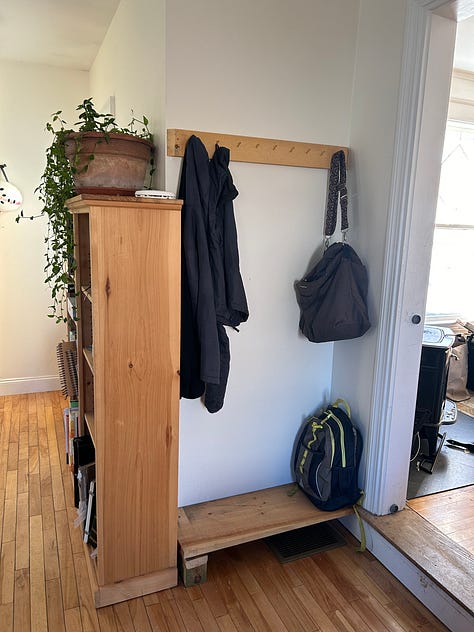
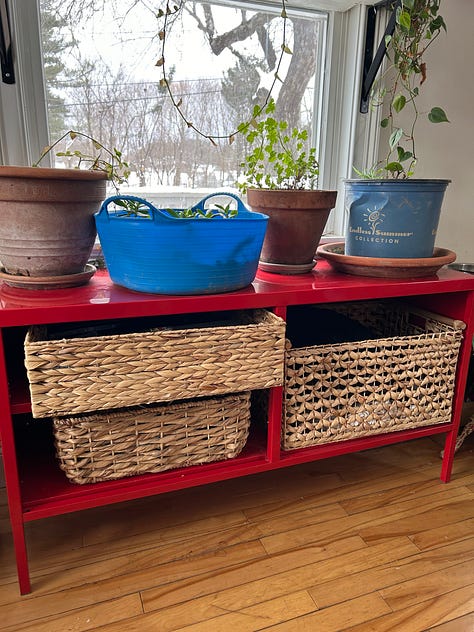
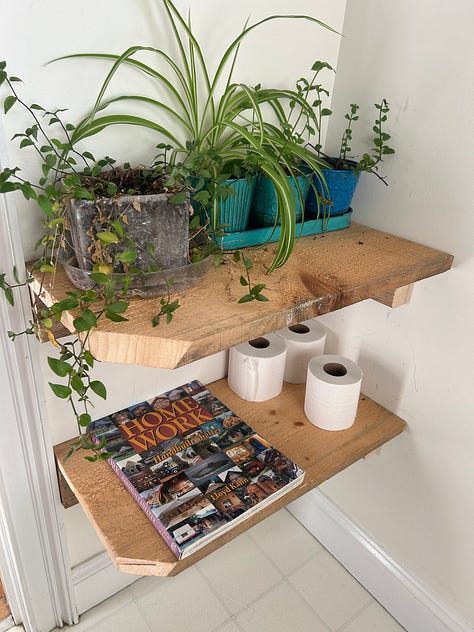
Which brings me to this gem: if you don’t make homes for objects, objects will make homes for themselves. Organizing involves creating “homes” for things, dedicated spaces where objects can be put away. And sometimes, within a space you put another space - a home within a home - to subcategorize something so it can dwell next to, but not be lost amongst, its friends. My Junk Drawer is a classic example of this, as it is a big shallow box, with a hinged top, housing (among other things) a bowl of rubber bands and twisty ties, a mug of string, a glass of keys, a bowl of small objects that I don’t wish to throw away but don’t know what else to do with, a few bags of Cadbury’s mini eggs, a collection of scissors, and so on. Before I built the Junk Drawer, these items spent a great deal of time loitering about the house, collecting grime, causing visual confusion, and disappearing just when I needed them.
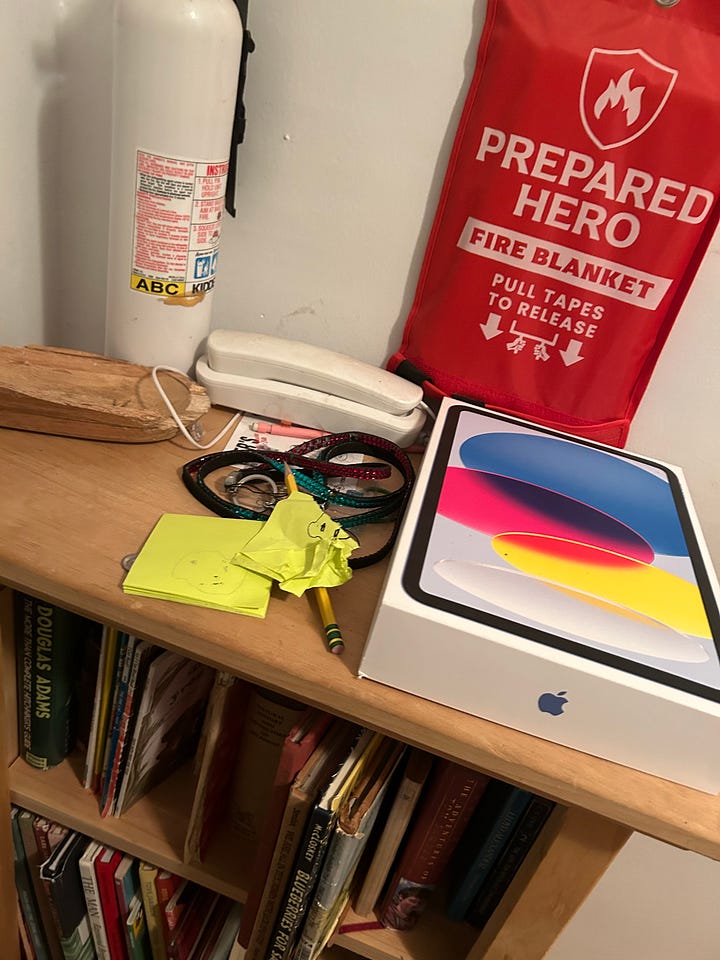
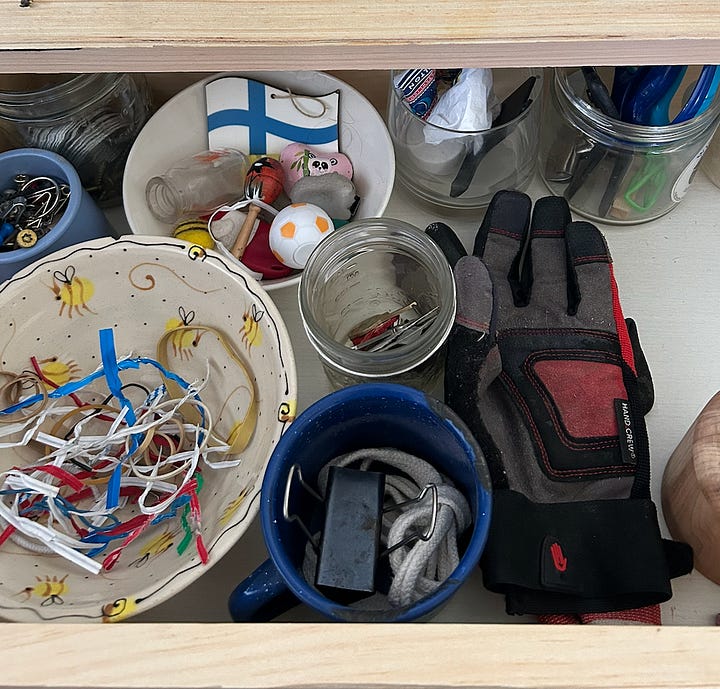
Junk drawers, baskets, shelves - all of these places are homes in which to PUT THINGS AWAY, which brings us to the final element of Roughhousing your interior space:
CLEAN: when you have created homes for all your objects, it should be possible to tidy a room in 2 to 3 minutes, and sweep and dust it in about 3 minutes. This is my concept of The Five Minute Room. Obviously, there will be exceptions - I do not count cleaning a post-meal kitchen in this calculation, since that will take more time, and of course some rooms are bigger than others - but basically, on average, 5 or 6 minutes should get you from cluttered to clean.
Every morning at 7:30 (with the occasional day off) I clean for half an hour. This tidies and freshens the most inhabited first-floor spaces (kitchen, bathroom, living room and entryway) in about 15 minutes, leaving 15 minutes for revolving tasks such as cleaning the stovetop, cleaning the bathrooms, vacuuming, etc. I make sure to clean fearlessly - getting at the nasty stuff at the base of toilets, the weird slime behind faucets, the unspeakable sticky grease on the top of the range hood. And once these things are dealt with, maintenance becomes much easier. Another gem for you: the more you clean things, the cleaner they become.
Here is a little video, sped up, of me cleaning the living room. It took 6 minutes in real time - NOTE: in the video I say it is “double speed”, but it is actually about 4X speed.
This process will look different depending on your particular space (a house, an apartment, a room) and your other domestic responsibilities (children and babies, pets, elders in need of care.) My household consists of myself, my husband, our two boys, two dogs and two cats; half an hour of daily cleaning is enough to maintain order and keep things fresh - and it is as much time as I am willing to commit to cleaning every day (of course I still do dishes, and other family members have their cleaning tasks as well). For other people, in other spaces, with other standards, this could require more time or less.
Getting it done early in the day is important for me, as it lets me get the job done before I have had a chance to talk myself out of it. I would previously have spent the half-hour between 7:30 and 8am doomscrolling on the internet, distracting my mind and dis-regulating my nervous system for the day ahead. Now I am much better prepared to settle down with a cup of tea and a sense of purpose and get to work. Even though I am not particularly bothered by disorder, a clean house is healthier, easier to navigate and more pleasant to inhabit. Plus it smells good: I favor cleaning with water, sometimes vinegar, Dr. Bronner’s soap, Thieves and anything with pure essential oils of peppermint or eucalyptus.
Please let me know in the comments if you have any good cleaning tips or systems that you have successfully maintained over time. Roughhousing is always seeking better ways to do things!
FULL DISCLOSURE! Sometimes I include Affiliate Links in my articles. This means that if you purchase an item from these links, I will receive a small commission. I only ever recommend items or companies that I have used and am VERY happy with - and if I ever link to an item that I haven’t used, I make this clear in the article.





